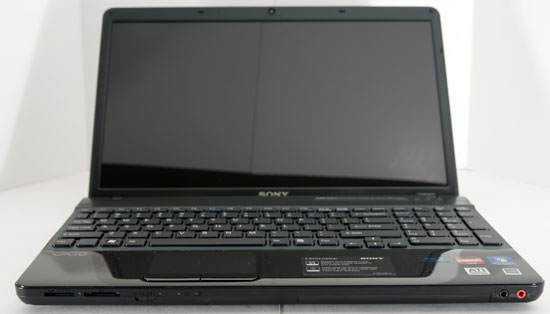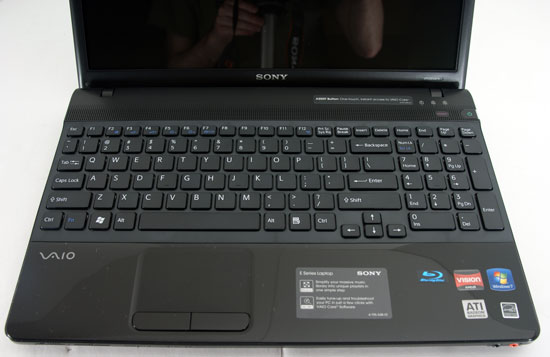Sony EE34: Sony Makes Budget AMD Laptops?
by Dustin Sklavos on February 22, 2011 4:43 PM ESTAn Inexpensive Vaio?
Notice in the headline I didn't use the word "cheap," and there's a reason for that. While there's a decent amount of glossy and matte black plastic and the overall build quality does feel a little more chintzy than some of Sony's more upscale models, as a whole the EE34 doesn't actually feel like a cheap machine.
Writing about the Sony Vaio EE34's looks is going to result in a fairly short review, and that's due largely to the prevalence of black matte plastic all over the build. Sony wisely eschews using glossy plastic on the lid, and though I've found it can still pick up dust it isn't a grease and fingerprint magnet. It thankfully seems like the era of glossy plastic really is finally drawing to a close.

The hinge of the lid allows the screen to tilt back about 135 degrees, allowing for a decent range for finding that sweet spot viewing angle, and the screen bezel itself is thankfully also a matte plastic. At this point only a couple of manufacturers seem to be persisting in putting that gloss where it doesn't belong; most of the others have moved on.
That matte plastic follows down to the inside panelling of the Vaio, through the speaker grille above the chiclet-style keyboard and stopping at the palm rest. Sony has opted to employ glossy plastic for the palm rest, integrated touchpad, and mouse buttons, but at least it kind of makes sense here. Because the gloss is a deep black it doesn't show fingerprints quite as badly as it could, and it's actually fairly attractive. This is probably how glossy plastics should have been used to begin with.

If you're a fan of chiclet-style keyboards you're liable to be at home with the Vaio EE34's. The keyboard has a smart layout that makes full use of the width of the notebook while having minimal flex, and the 10-key is comfortable to use with document navigation keys wisely placed above it. About the only complaint one could reasonably make about Sony's keyboard is that the keys themselves feel a bit on the small side, but most users should be able to get used to them without too much trouble.
The touchpad is textured and is fine for general use, but it's still another perpetrator of one of those cheapest of crimes: being a part of the inside panel instead of being apart from the inside panel. This is something that has very seldom looked good, and while Sony almost pulls it off with the EE34 it still feels like a cut corner. Given the budget nature of this notebook that's something that we can overlook, and the touchpad (and accompanying mouse buttons) has a good enough feel to it that you're not going to be cursing their engineers every time you have to use it.
Upgrading the Vaio EE34 is thankfully not too arduous a task, although a series of little details on the bottom just scream Sony eccentricity. The battery hinges into the notebook in a way that's going to seem unusual; you'd expect it to just slide into the back the way most laptop batteries do, but this one actually has to be inserted at an angle, then canted in and snapped into place. And while the hatch for upgrading the RAM is easy enough to access (single screw, panel pops off), the hard drive bay winds up being sillier than it looks. After unscrewing that panel, you actually have to slide it off instead of just lifting it up. None of these are major problems and they're really only worth mentioning because they're fitfully amusing. If you're used to removing these things in a lot of other notebooks you'll pause for a second and go "wait, what?"
As a whole the EE34 doesn't feel particularly chintzy and at least looks better than a lot of other budget notebooks in its price range. Some users aren't big fans of Sony's designs, but I've always found Vaios to be attractive, stylish notebooks and this one is no different.
















52 Comments
View All Comments
piroroadkill - Wednesday, February 23, 2011 - link
You don't always need to buy cheap junk. Lenovos aren't too bad though.Quick example, my main laptop is a Dell Latitude D800, which still works perfectly now with a new hard disk and 2GB RAM upgrade, and Windows 7, alongside the existing 2GHz Pentium M and Radeon 9600 Pro Turbo (128MB).
That must be 6 years old. It has a nicer screen than anything I could get now (1920x1200).
I don't need to upgrade it unless I wanted to play 1080p video or new games.
Stuka87 - Tuesday, February 22, 2011 - link
I too had no clue Sony made a budget laptop period, much less a laptop with an AMD in it. And it actually looks like a pretty nice machine for the price.And it was a nicely written review at that.
roko98 - Tuesday, February 22, 2011 - link
"I've been paid to fix those computers. I don't like doing it anymore. There are bargains, and then there's getting what you pay for. When my dad's girlfriend complains because the illegal immigrant she paid a paltry eight bucks an hour to take care of her front yard didn't do a very good job, she sounds dense."Maybe you are right, maybe not. Please keep it for yourself. This comment doesn't fell right for a very professional site like Anand's. If you skip this... good review.
Jumangi - Wednesday, February 23, 2011 - link
Oh noes!!! Here comes the PC police!We all know its supposed to be "undocumented immigrant"...don't want to make the progressives angry...
Nfarce - Wednesday, February 23, 2011 - link
Exactly why does the phrase "illegal immigrant" get liberals so upset? What part of illegal and immigrant in the phrase "illegal immigrant" is not hard to understand? It is what it is whether one is from South America, Europe, or Indofreakingchina. Get over yourselves.7Enigma - Friday, February 25, 2011 - link
I'll be honest, I could care less about PC comments (see the other comments below), but I also agree it just didn't fit in the piece. Seemed to me like an extra paragraph was needed for the article and this fluff was thrown in to pad the page. Not all of us have a great deal of free time and I doubt the target audience of this piece needs/cares about someone complaining about yard work.Stick to the substance, and we'll be happy.
RaistlinZ - Wednesday, February 23, 2011 - link
So basically, they got all the cheapest components they could find and wrapped them around a Blu-Ray player for $600. This thing offers netbook performance for a higher cost. Why put a Blu-Ray with a crappy screen to watch it on?13x7 resolution? 5200 rpm HDD? 10 fps average on games? I don't see a market for this thing. Maybe at $400, but not at $600.
Calabros - Wednesday, February 23, 2011 - link
I prefer budget notebooks, cause if it lost or stole or dropped, I loose $600 not 1.5KHHCosmin - Wednesday, February 23, 2011 - link
nice to see sony making an... ahem... less expensive lappie.first thing is i think people over value the cpu power. laptops are more about mobility: weight, autonomy, durability and less about horse power. don't like much the optical drives. there a lot of ways to carry data besides optical drives: sticks, online, nas etc.
runtime... this is one of the things that plagued amd.... but you see notebooks are not made by amd but by integrators: acer, asus, sony etc. so the runtime is not the cpu runtime but the platform runtime. well the platform is the integrator business. since amd was mostly for cheap builds then the integrators cared very little for making a good platform with good runtime. my point is that we get a laptop with same battery, same cpu, same ram amount, comparable hdd, same igp we will get the same perfromance.... but bingo!... not the same runtime. in fact we may get big differences and this is the case with intel too. my hunch is that the lame runtime under idle - low, video play usage of a laptop is the integrator's fault. and the driver makes also.
so congrats for sony on making a good build and caring about runtime.
the cpu power is enough, the runtime is at last ok as sony cared about it, the price is ok
jabber - Wednesday, February 23, 2011 - link
Indeed. Folks cant get their minds out of the turn of the century CPU power struggle that you always have to have more.As soon as we got dual core CPUs the power struggle came to an end for 80% of users.
The needs of the many have long since been met.
I've been using a 1.3GHz CULV laptop for the past year and its been superb. Never once have I found it wanting. I cant tell the difference performance wise to some of the i3/i5 laptops I've worked on. Its no different in 95% of tasks other than video encoding.
Oh and did I mention that I get nearly 7 hours running time from it?
In fact my 3.5GHz quad-core crossfire box has pretty much been relegated to video encoding.
More power to the low power revolution.